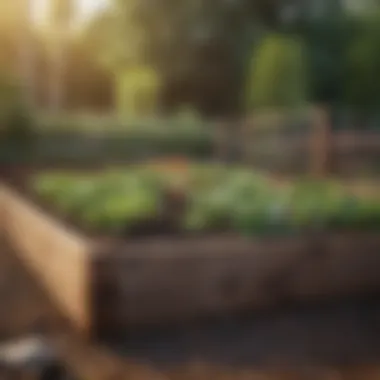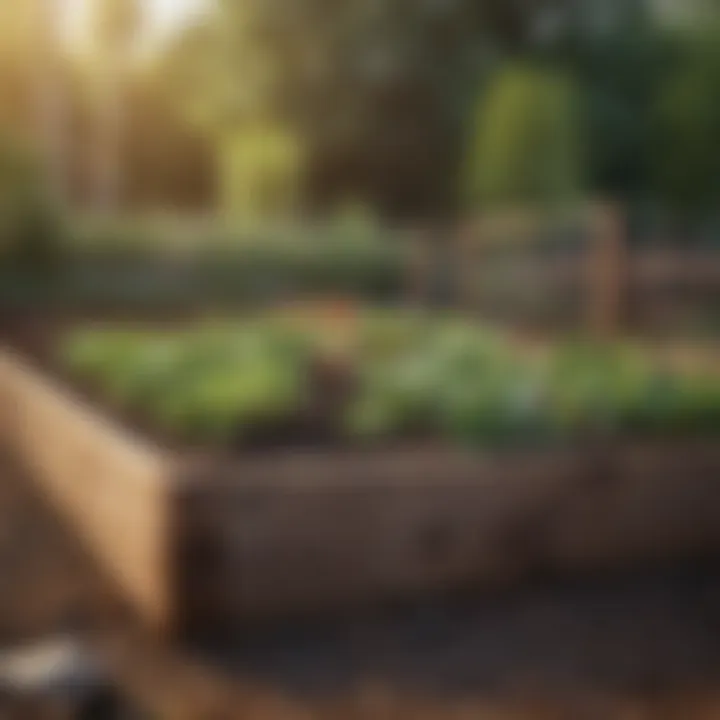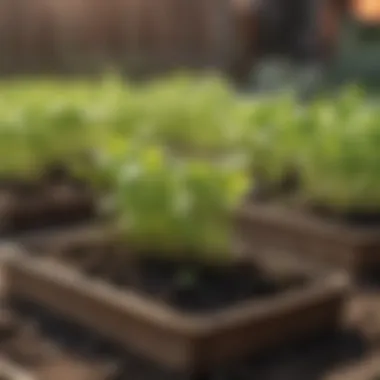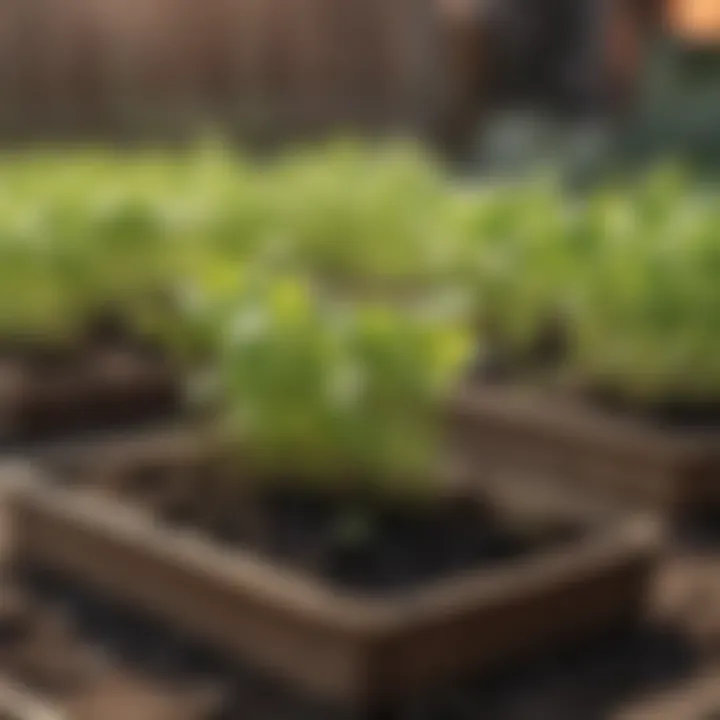Mastering the Art of Raised Bed Gardening


Intro
Creating a raised bed garden is more than a trend; it offers numerous advantages for gardeners of all experience levels. This approach allows for improved soil quality, better drainage, and easier maintenance. As you consider setting up your raised bed garden, understanding the critical steps and factors involved will enhance your chances for success.
In this guide, we will cover essential aspects such as site selection, material considerations, soil composition, planting strategies, and ongoing maintenance. Whether you're looking to cultivate a few herbs or transform your backyard into a comprehensive vegetable haven, this guide provides a framework that can help you achieve your gardening ambitions.
Preface to Raised Bed Gardening
Raised bed gardening is a method that allows gardeners to cultivate plants in a controlled environment. The process offers numerous advantages, making it a favored approach among gardening enthusiasts. The introduction of raised beds transforms the gardening experience, addressing many common problems associated with traditional gardening practices.
When considering raised bed gardening, the benefits become immediately evident. By elevating plants, gardeners can enhance accessibility, improve soil quality, and extend the growing season. All these features combine to create an environment that is conducive to healthy plant growth. Understanding these aspects is crucial for anyone looking to establish a successful raised bed garden.
Definition and Overview
A raised bed garden is a garden that is set above the surrounding soil level. It is typically constructed using wood, stone, or other materials. The bed is filled with a specially designed soil mix that provides optimal growing conditions. This method allows for better control over soil quality and depth. The walls of the raised bed protect the plants from pests and can help maintain moisture levels. As a result, gardeners can create a more ideal setting than what traditional ground gardening often provides.
Benefits of Raised Bed Gardening
Raised bed gardens come with several noteworthy benefits that can significantly enhance the gardening experience:
Improved Soil Quality
Improved soil quality is a principal advantage of raised bed gardening. Unlike traditional plots, where soil can be compacted and depleted of nutrients, raised beds allow for a customized soil mix. This means that gardeners can create a rich blend of topsoil, compost, and organic matter. Such a mix promotes healthier plants by providing essential nutrients and improving root growth. By controlling the soil environment, raised beds also minimize contamination from nearby areas, enhancing overall plant health.
Easier Access for Maintenance
A key characteristic of easier access for maintenance is the elevated nature of raised beds. This feature makes it possible for gardeners to tend to their plants with greater comfort. No bending down or kneeling is necessary, which can be particularly beneficial for those with mobility challenges. Furthermore, with clear defined boundaries, it is simpler to organize garden tasks such as weeding or harvesting, resulting in a more efficient gardening routine.
Better Drainage and Aeration
Better drainage and aeration are critical factors in successful plant growth. Raised beds facilitate excess water to drain away, preventing root rot and other water-related issues. The elevation allows for increased air circulation within the soil, promoting healthier roots and reducing the risk of disease. These features make raised beds an appealing choice for regions with heavy clay soils or areas prone to flooding.
Extended Growing Season
The extended growing season is another notable benefit of raised bed gardening. Beds warm up more quickly in the spring compared to ground soil. This can lead to earlier planting, enabling gardeners to enjoy a longer harvest period. In the fall, raised beds continue to retain heat, allowing for late-season crops to thrive longer than they would in traditional gardens. This adaptability makes raised beds advantageous for optimizing the gardening calendar.
"Raised bed gardening enhances the overall gardening experience by improving accessibility, soil health, and plant growth conditions."
In summary, raised bed gardening offers crucial benefits that align well with both novice and experienced gardeners' needs. Awareness of these advantages informs the setup and maintenance of a successful raised bed garden, leading to fruitful yields and a satisfying gardening journey.
Selecting the Ideal Location
Choosing the right location for a raised bed garden is fundamental for its success. Several factors impact plant growth, and understanding how to select a suitable site can mean the difference between thriving plants and disappointing yields. Evaluating sunlight, drainage, and proximity to resources, such as water and your home, will set a solid foundation for your gardening efforts.
Evaluating Sunlight Exposure
Full Sun vs. Partial Shade
Sunlight is needed for photosynthesis, making its evaluation crucial. Plants generally fall into categories based on their sunlight needs. Full sun means at least six hours of direct sunlight per day, while partial shade indicates four to six hours.
Full sun is a popular choice among gardeners because it supports a greater variety of crops, especially vegetables like tomatoes and peppers. When plants receive ample sunlight, they tend to grow larger and produce better yields. However, some plants, such as lettuce and spinach, prefer partial shade. Selection often depends on the climate and the specific crop.
The advantage of full sun is clear: more light typically equals more growth. However, in hotter climates, too much sun can lead to plants wilting or suffering from heat stress. On the other hand, partial shade can help moderate temperatures, extending the growing season for those delicate plants. When considering where to place your raised bed, think about the sun's path throughout the day and how it affects your planting area.
Assessing Drainage and Water Access
Good drainage is a key consideration when selecting a location, as standing water can lead to root rot and other issues. Observe the area during heavy rain to see how water collects. If puddles form, it may not be the best spot for planting. Ideally, raised beds should be placed on slightly elevated areas to promote good drainage.
Additionally, easy access to water is another critical factor. Being close to a water source can simplify the irrigation process. Consider implementing a drip irrigation system or keeping a watering can nearby for hand watering. Ensuring your plants receive the right amount of water is essential for their survival and productivity.
Considering Proximity to the Home
The location of your raised bed should also be convenient. Having it near your home allows for effortless monitoring and maintenance. You are more likely to catch pests or weeds quickly if the garden is close by. It also makes harvesting easier, encouraging a more frequent use of your garden's bounty.
Choosing Materials for Raised Beds
Selecting suitable materials for raised beds is vital. This choice affects durability, soil quality, and the overall aesthetic of your garden. Material selection can impact not just the structure of the garden, but also the plants growing in it. Understanding the pros and cons of various materials ensures long-term success in gardening efforts.
Wood Options
Cedar
Cedar is often favored for raised bed gardening due to its natural resistance to decay. This wood contains oils that give it resistance to insects and fungi. It is lightweight, making it easy to work with, and it blends well in natural settings. While cedar may be more expensive than other woods, its longevity often offsets the initial cost.
Its unique feature is its beautiful appearance, which adds to the visual appeal of the garden. However, cedar can warp or twist over time if not properly treated, which is something to keep in mind.
Redwood
Redwood shares some similar qualities with cedar; it is also naturally resistant to insects and rot. Many gardeners prefer redwood for its rich color and grain, which adds a distinct touch to any garden. The significant advantage of redwood is durability, lasting many years. However, like cedar, its cost can be higher. It is also a limited resource, which raises concerns about sustainability. There is a tendency for redwood to be less available than other materials, so careful sourcing is necessary.
Treated Lumber
Treated lumber is chemically treated to resist pests and decay. This option is often less expensive than natural woods. Its primary feature is durability; it can last longer than untreated wood in harsh weather. However, there are concerns regarding chemical leaching into the soil. Some organic gardeners prefer to avoid treated lumber for this reason. It is crucial to know the type of treatment, as not all chemicals are safe for vegetable gardens. Proper precautions need to be taken in using treated lumber in gardening.
Non-Wood Alternatives
Metal


Metal beds, commonly made from galvanized steel or aluminum, offer durability and a modern look. They can retain heat, which can be beneficial for certain plants. Metal does not warp or rot like wood. However, they can become quite hot in the sun, potentially harming roots. It is also essential to ensure they are free from toxic coatings. Using untreated or food-safe metal is recommended for growing edible plants.
Concrete
Concrete raised beds are sturdy and long-lasting. Their weight makes them stable against strong winds and other environmental factors. Concrete allows for unique shapes and designs that can enhance garden aesthetics. However, it can be challenging to manage temperature; concrete can absorb heat, which may harm roots in hot weather. Also, initial installation requires significant effort and planning.
Bricks
Bricks provide a traditional and attractive option for raised beds. They are durable and offer good insulation for plant roots. A distinct feature of bricks is versatility; they can be arranged in various styles and designs to fit the gardener's creative vision. On the downside, brick can be expensive, depending on the type chosen. Also, the weight can make installation more labor-intensive.
Remember: The material you choose not only affects the structure of the raised bed but also influences the health of the garden ecosystem.
Choosing the right material is a balance of budget, aesthetics, durability, and environmental concerns. Making an informed choice empowers gardeners to create raised beds that are not only functional but also contribute positively to the gardening experience.
Designing the Raised Bed Structure
Designing the raised bed structure is crucial in establishing a successful garden. The structure affects everything from drainage to cultivation ease. A well-thought-out design can enhance plant health and facilitate easier maintenance. It can maximize space efficiency and minimize the strain on the gardener. Each element must be considered carefully in this process, including dimensions, materials, and building techniques.
Determining Bed Dimensions
Height Considerations
Height considerations are often overlooked but play a vital role in raised bed gardening. The height of the beds impacts not only the accessibility but also the types of plants that can be grown successfully. Typical heights range from 12 to 30 inches, depending on the user’s needs and garden style.
A taller bed is beneficial for those with mobility issues, allowing for easy access without bending over. A height of 24 inches is often recommended if targeting this need. However, less height can be ideal for certain crops or if plants require deeper roots.
A well-planned height can improve air circulation, water retention, and soil warmth, leading to better growth conditions.
The disadvantage can be the material and soil costs, which increase with height. Choose a height that aligns with your gardening goals and physical capabilities.
Width and Length Guidelines
Width and length guidelines define the overall layout of your raised bed. A common width is around 4 feet, making it accessible to reach from either side. This width allows easy access for planting, weeding, and harvesting without needing to step into the bed, which can compact the soil.
Concerning length, the options can vary widely, but a length range of 8 to 12 feet is ideal. This ensures adequate space for diverse crops while allowing easy navigation between beds.
Lengthier beds may require more support to prevent sagging; hence, shorter segments might be better for novice gardeners.
Inappropriate dimensions can lead to management challenges. For example, too wide beds can become difficult to maintain, leading to neglected crops. Meanwhile, very long beds can limit access and hinder care.
Building Techniques and Joinery
Building techniques and joinery are essential for constructing sturdy and lasting raised beds. Utilizing the right methods can ensure beds withstand weather conditions and last for years. Common techniques include using screws or nails for wooden beds, while metal beds may require fewer fasteners but ensure strong seams.
Adjusting corners with reinforcing brackets can improve stability. This is especially important in larger beds that bear the weight of soil and plant growth.
Proper joinery prevents warping which can happen due to environmental exposure. Adequate joining also prevents soil loss which can occur with poorly constructed beds. Therefore, understanding the construction techniques is crucial for the longevity of your raised bed gardening.
Selecting the best building material and joint method can increase satisfaction with your project while supporting your gardening efforts efficiently.
Soil Composition and Preparation
Soil composition and preparation are crucial steps in setting up a raised bed garden. Healthy soil influences plant growth significantly. Different components in the soil affect how well plants can absorb water and nutrients. Understanding what makes a good soil mix can lead to better gardening results.
Selecting the Right Soil Mix
Choosing the right soil mix for your raised beds is fundamental. It can enhance plant growth and health. The following options are frequently used:
Topsoil
Topsoil is the uppermost layer of soil, rich in nutrients. Its key characteristic is its fertility. Topsoil is popular because it contains essential minerals and organic matter. Its unique feature is that it provides a solid foundation for plants. The mix of sand, silt, and clay gives it the ability to retain moisture. However, a disadvantage could be inconsistency in quality. Sourcing quality topsoil from a reliable location is key to avoid contaminants.
Compost
Compost is decomposed organic material. It enriches soil, improving its structure and nutrient content. The quality of compost varies, but it generally enhances soil fertility. Its unique feature is its ability to increase microbial activity in the soil, promoting healthier plant roots. Even though compost provides numerous benefits, it might require regular replenishing to maintain nutrient levels. Ensuring a balanced ratio when mixing with topsoil is also important.
Organic Matter
Organic matter consists of decomposed plants and animals. It significantly contributes to soil health and structure. A key characteristic is its ability to improve soil aeration and water retention. It's a beneficial choice for raised bed gardening because it promotes biodiversity in the soil. The unique feature of organic matter is how it stores nutrients for plants during dry spells. However, it can take time to break down and may need to be added regularly to maintain its benefits.
Testing Soil pH and Nutrients
Testing your soil’s pH and nutrient levels is critical for optimal plant health. The pH scale ranges from 0 to 14, with 7 being neutral. Most vegetables prefer a pH between 6.0 and 7.0. Testing kits are available at garden centers. Knowledge of nutrient levels helps in choosing fertilizers. You can adjust pH using lime to raise it or sulfur to lower it. This showcases the importance of pre-planting soil assessment.
Layering Techniques for Soil Preparation
Layering is an effective technique for preparing raised bed soil. This technique involves creating layers of different materials, each contributing unique benefits. A common method is the "lasagna garden" approach, which alternates layers of browns (carbon-rich materials) and greens (nitrogen-rich materials). The benefits include improved drainage and aeration, along with enhanced microbial activity. Ensuring proper layering can increase efficiency when planting. It is essential to keep in mind that the right combination of layers can vary, based on the specific needs of the plants you aim to grow.
In summary, proper soil composition and preparation is fundamental for the success of a raised bed garden. Understanding the roles of topsoil, compost, and organic matter allows gardeners to create a nurturing environment for plants. Testing soil pH further fine-tunes conditions to promote growth. Finally, layering techniques enhance soil structure and fertility, providing a solid base for any gardening venture.
Planting Strategies
Planting strategies are crucial in raised bed gardening. Choosing the right plants and knowing how to space them properly leads to better growth, healthier plants, and ultimately a more productive garden. This section will explore key elements like crop selection, spacing, and seasonal planting to ensure a successful gardening experience.
Crop Selection and Compatibility


Vegetables
Vegetables play a vital role in raised bed gardening. They provide essential nutrients for a healthy diet and contribute to the overall aesthetics of the garden. Many vegetables are well-suited for life in a raised bed, such as tomatoes and peppers. This is due to their adaptability in various conditions. The unique feature of these vegetables is their high yield in small spaces. However, it is important to consider potential companion plants, as some vegetables do not grow well together, affecting their growth.
Herbs
Herbs are another excellent choice for raised bed gardens. They are known for their aromatic qualities and culinary uses. Herbs like basil, mint, and rosemary thrive in confined garden spaces. Their key characteristic is that they can attract beneficial insects, boosting overall garden health. While most herbs do not require as much space as vegetables, their growth may vary depending on light and water availability, which makes planning important.
Flowers
Flowers can greatly enhance the beauty of a raised bed garden. They add color and attract pollinators, like bees and butterflies, which are essential for plant reproduction. Popular flowers include marigolds and zinnias due to their vibrant colors. Adding flowers to a vegetable garden can create a visually appealing space. However, it is crucial to consider their growth habits as some flowers may compete with vegetables for resources, so placement is a key consideration.
Spacing and Depth Considerations
Proper spacing between plants prevents overcrowding, which can lead to disease and competition for nutrients. For vegetables, a general guideline is to follow the advice on seed packets or plant labels regarding spacing. Deeper beds allow roots to expand more freely, which is especially beneficial for root vegetables like carrots and beets. Careful planning in spacing leads to healthier plants and maximizes yield.
Seasonal Planting Guides
Timing is essential in gardening. Different plants have specific seasons when they thrive best. A seasonal planting guide helps determine the right time to sow seeds or transplant seedlings. Cool-season crops, like kale, can be planted in early spring or fall, while warm-season crops, such as cucumbers, thrive when the temperature rises. Understanding seasonal changes ensures that gardeners can optimize their yields throughout the year.
Key takeaway: Effective planting strategies directly impact the success of raised bed gardens. By carefully selecting compatible crops, planning their spacing, and following seasonal guidelines, gardeners can cultivate a healthy, thriving garden.
Watering Techniques and Management
Watering is a critical component in raised bed gardening. Maintaining the correct moisture level in the soil is vital for plant growth. Plants require consistent hydration to ensure that nutrients are absorbed effectively. Without adequate water, even the best soil mix will not suffice. The right watering technique can influence yield and health of crops, making this a key topic in successful gardening practices.
Effective management of watering techniques offers several benefits. It helps in conserving water, reducing waste. Choosing the right method can also minimize common problems such as over or under watering, both of which can lead to plant stress and reduced productivity. Here we will explore two primary watering methods: drip irrigation and hand watering.
Irrigation Methods
Drip Irrigation
Drip irrigation is a method that delivers water directly to the base of plants through a system of tubing and emitters. One key characteristic of drip irrigation is its efficiency. It minimizes water loss due to evaporation and runoff. This makes it a beneficial choice for homeowners looking to conserve water while still providing for their plants' needs.
The unique feature of drip irrigation is how it can be tailored for specific plants. By adjusting the flow rate, you can provide varying levels of moisture depending on the individual plant's needs. This customized approach reduces water waste and encourages deep root growth, offering significant advantages. However, it does require an initial investment in materials and setup.
Advantages of drip irrigation include the following:
- Water Conservation: It uses less water compared to conventional watering methods.
- Reduced Weeds: Water only goes to the plants, minimizing moisture for weeds.
- Time Savings: Once set, it requires less manual labor to maintain.
A disadvantage is that the system can be complex to install. Also, emitters can clog over time, requiring regular maintenance.
Hand Watering
Hand watering involves using a hose or watering can to deliver water manually to the plants. This method's main characteristic is its simplicity. It allows for careful application of water directly where it is needed. Hand watering is a common choice for smaller gardens or for gardeners who want more control over their watering practices.
The unique feature of hand watering is the direct interaction it provides between gardener and plant. This hands-on approach allows the gardener to assess the health of plants closely, which aids in identifying issues early on. However, it does require more time and effort compared to other methods.
The advantages of hand watering are:
- Flexibility: You can adjust water flow according to immediate needs.
- Observation: Easier to notice signs of stress or pests.
- Cost-Effective: No special equipment needed.
Disadvantages include the potential for uneven distribution of water, leading to dry spots and over-saturated areas.
Watering Schedules and Guidelines
Establishing a watering schedule is crucial. It's important to water at the right times, such as early morning or late evening, to avoid evaporation losses. Consistency in watering helps maintain soil moisture and supports healthy growth.
A beneficial guideline is to check the soil moisture regularly. This can be done by sticking a finger into the soil. If it feels dry to the second knuckle, it is usually time to water.
When planning a watering schedule, consider:
- Plant Needs: Different plants have different water requirements.
- Weather Conditions: Adjust for rain or hot weather.
- Soil Type: Sandy soils may need more frequent watering compared to clay soils.
Consistent and efficient watering can significantly impact the success of your raised bed garden.
By integrating the right watering techniques and establishing a sensible schedule, gardeners can enhance the vitality and resilience of their plants.
Maintenance Practices
Maintenance practices are crucial for the longevity and productivity of a raised bed garden. Regular upkeep ensures that the plants thrive and any potential issues are addressed promptly. This section will explore different aspects of garden maintenance, including weed control, pest management, and nutrient management.
Weed Control Strategies
Weeds compete with garden plants for resources like water, light, and nutrients. To maintain a healthy garden, it is essential to implement effective weed control strategies. Some common methods include:
- Mulching: Adding a layer of mulch helps suppress weed growth and retain moisture. Organic mulches, such as straw or wood chips, also improve soil quality as they decompose.
- Hand Weeding: Regularly inspecting the garden and removing weeds by hand can prevent them from spreading. It is often most effective when the soil is moist, making it easier to pull out the roots.
- Weed Barrier Fabrics: These materials can be laid down before planting. They block sunlight and thus inhibit weed growth while allowing water and nutrients to seep through.
Choosing the right method depends on the specific needs of the garden and the types of weeds present. By incorporating these strategies, gardeners maintain a manageable and productive environment.
Pest Management Techniques
Pest management is a vital component of maintaining a healthy garden. Many gardeners face challenges from insects and other pests that can weaken plants and reduce yields. To manage pests effectively, several techniques can be employed:
- Crop Rotation: Changing the location of certain crops each year can prevent pests from becoming established and reduce disease transmission.
- Natural Predators: Introducing or encouraging beneficial insects, like ladybugs, can help control pest populations naturally. They feed on pests such as aphids and spider mites.
- Organic Pesticides: For severe infestations, organic options like neem oil or insecticidal soap can be used. These are effective against a variety of pests while minimizing damage to beneficial insects and the environment.


It is essential to monitor the garden regularly for signs of pests and to act quickly. Integrated Pest Management (IPM) combines these strategies for a holistic approach.
Fertilization and Nutrient Management
The health of plants is heavily influenced by soil nutrients. Therefore, effective fertilization and nutrient management are key to a rich harvest. A few important aspects of this practice include:
- Soil Testing: Regular testing of the soil helps determine nutrient levels and the pH balance. This information is crucial for making informed amendments.
- Organic Fertilizers: Using compost, well-rotted manure, or organic fertilizers adds nutrients back into the soil. These amendments improve soil structure and microbial activity.
- Sustainable Practices: Cover cropping and crop rotation naturally enhance nutrient levels in the soil. These practices decrease the need for synthetic fertilizers while improving soil health over time.
By understanding and applying these fertilization techniques, gardeners can support their plants effectively, ensuring robust growth and an abundant yield.
Regular maintenance is essential for the long-term success of a raised bed garden, ensuring sustainable practices lead to fruitful yields.
Seasonal Adjustments and Preparation
Seasonal adjustments and preparation are critical for the success of your raised bed garden. Understanding the changes in temperature, growing seasons, and climatic conditions helps in maximizing plant health and yield. Each season brings its unique challenges and opportunities that demand thoughtful planning. By adapting your gardening practices to these seasonal shifts, you can enhance the sustainability of your garden, maintain environmental balance, and ensure productivity throughout the year.
Being proactive about seasonal changes enables gardeners to optimize resources like water and nutrients, reducing waste while promoting healthier plants. Therefore, you must keep in mind the distinct requirements for both winter and spring, which are crucial times for raised bed gardening.
Preparing for Winter Season
Preparing your raised bed garden for the winter months involves various strategies to protect plants and soil. Start by clearing out any remaining vegetation, as decomposing plant material can encourage diseases and pests. If you have perennial plants, cut back dead foliage to promote new growth in the coming spring.
Another option is to apply a layer of mulch, which helps to insulate the soil. This insulation protects roots from frost and preserves moisture. Using organic mulches such as straw or shredded leaves provides added benefits by breaking down and enriching the soil once spring arrives.
Consider adding a green manure crop, like clover or winter rye, which can improve soil structure and nutrient levels. These cover crops will grow during winter and can be tilled into the garden bed before planting in spring. Additionally, depending on your climate, you might want to cover your raised beds with row covers or cloches, which offer extra protection against extreme cold.
Spring Preparation Tips
As spring approaches, preparing the raised bed for the growing season becomes paramount. Start by removing winter covers and any debris that accumulated during the colder months. Inspect your soil, as it may need amendments to restore nutrients lost through leaching. Adding compost or aged manure can enhance soil fertility and structure.
Ensure that the soil is workable, breaking up any clumps and mixing in organic material to promote aeration. This aeration is essential for root development as it improves drainage and enhances access to oxygen.
Planning your planting schedule is vital now. Evaluate your local frost dates and choose crops accordingly, ensuring they are planted at the optimal times to thrive. A mix of cool-season crops like peas and spinach, along with warm-season options such as tomatoes and peppers, will maximize output throughout the growing season.
Proper seasonal adjustments increase productivity and sustainability in raised bed gardens, allowing homeowners to enjoy a flourishing landscape.
In summary, adjustments and preparations tailored to seasonal changes are essential in maximizing the gardening experience. By preparing adequately for winter and spring, gardeners can foster healthier plants and a more productive garden.
Common Challenges and Solutions
Establishing a raised bed garden can bring about various challenges that gardeners must navigate. Understanding these common issues and their corresponding solutions is crucial for creating a thriving gardening environment. By addressing challenges such as poor soil quality or pest infestations, gardeners can sustain healthy plants and enjoy a fruitful harvest. This section will offer guidance on overcoming these obstacles, allowing you to reap the benefits of your raised bed gardening efforts without undue frustration.
Dealing with Poor Soil Quality
Soil quality plays a vital role in the success of any garden, including raised beds. Even if you start with nutrient-rich mixes, soil quality can degrade over time due to various factors. It is common for gardeners to encounter problems like compaction, nutrient leaching, or the presence of contaminants in the soil.
To address poor soil quality:
- Regular Testing: It is advisable to test soil pH and nutrient levels every season. A simple soil test kit can reveal important information. If pH levels are off, amendments such as lime or sulfur can restore balance.
- Amending Soil: Incorporate organic matter such as compost or well-rotted manure. These amendments enhance soil structure, aeration, and fertility.
- Rotation of Crops: Practice crop rotation annually. This helps prevent soil depletion and reduces pest populations, leading to healthier soil.
In summary, continual monitoring and proactive amendments are key to managing soil quality effectively.
Pest and Disease Troubles
Pests and diseases are inevitable threats to any garden, and raised beds are not immune. Gardeners must be vigilant about identifying potential threats early to minimize damage. Pests can vary widely, from aphids to snails, each with specific vulnerabilities. On the other hand, diseases can arise from factors including poor air circulation and excess moisture.
To combat pests and diseases:
- Regular Inspections: Frequent checks for signs of pests or disease can help in early intervention. Look for discoloration, holes in leaves, or unusual growth patterns.
- Companion Planting: Utilize companion planting strategies to deter pests. Some plants naturally repel certain insects, creating a less hospitable environment for them.
- Organic Treatments: Implement organic pesticides like neem oil or insecticidal soap when necessary. These treatments are effective against pests while being less harmful to beneficial insects.
- Cultural Practices: Incorporate good cultural practices like proper spacing for air circulation and sufficient drainage. These practices can greatly reduce the risk of diseases.
Maintaining vigilance and employing integrated pest management strategies can significantly reduce the impact of pests and diseases on your raised bed garden.
"A proactive approach to pest and disease management allows for an enjoyable gardening experience, reducing worry over potential threats."
The End and Future Considerations
In the world of gardening, establishing a raised bed garden brings countless rewards. This section emphasizes the significance of understanding how to effectively draw together the various threads of knowledge discussed throughout this guide. The conclusion is more than just a wrap-up; it highlights the enduring benefits that such a gardening approach offers homeowners, especially those wishing to cultivate their green spaces with efficiency and creativity.
Reflecting on the journey of raised bed gardening, it is crucial to remember the impact of each decision made throughout the process—from selecting an ideal location to choosing appropriate materials for the beds. Each of these choices contributes to the performance and sustainability of the garden. Ensuring good soil composition, proper watering techniques, and weed management are all critical elements for successful growth.
Another primary element to consider is the adaptation and continuous learning that come with gardening. Each season brings its own challenges and opportunities. Engaging in seasonal adjustments, for instance, prepares the garden for varying weather conditions, ensuring that the plants are well-supported throughout their growing cycle. Moreover, the conclusion underscores the need for ongoing evaluation and improvement, which can ultimately lead to a more fruitful gardening experience.
Encouragement to practice sustainable gardening goes beyond philosophical ideals; it encompasses real benefits for the environment and personal satisfaction.
"Sustainable practices in gardening create a more resilient ecosystem and promote biodiversity."
Summary of Key Points
In summarizing the guide, several key points stand out:
- Location is critical: Good sunlight exposure and adequate drainage directly influence plant health.
- Material selection matters: The choice between wood and non-wood options for building raised beds impacts longevity and aesthetics.
- Soil health is essential: Proper preparation of soil, including testing pH levels, significantly affects plant growth.
- Effective watering methods: Utilizing drip irrigation and smart scheduling promotes consistent moisture without over-watering.
- Ongoing maintenance is vital: Regularly managing weeds, pests, and nutrient levels ensures high productivity.
Encouragement for Sustainable Practices
As the interest in gardening grows, incorporating sustainable practices becomes increasingly relevant. Homeowners and gardening enthusiasts can take pride in knowing they are contributing positively to their environment. Simple actions like composting organic waste, using organic pest control methods, and selecting native plants can significantly enhance the garden's ecosystem.
Moreover, utilizing resources efficiently not only conserves energy and materials but also helps in preserving the surrounding nature. Making informed choices around gardening inputs can promote a healthier environment and a more productive garden in the long run.
Encouraging neighbors and the community to join in these sustainable endeavors fosters a collective effort towards ecological responsibility. Sharing knowledge, tools, and even produce can create a more vibrant, interconnected gardening community.
Exploring the world of raised bed gardening leads one into a more sustainable and productive lifestyle, where each effort contributes to personal well-being and environmental health.















